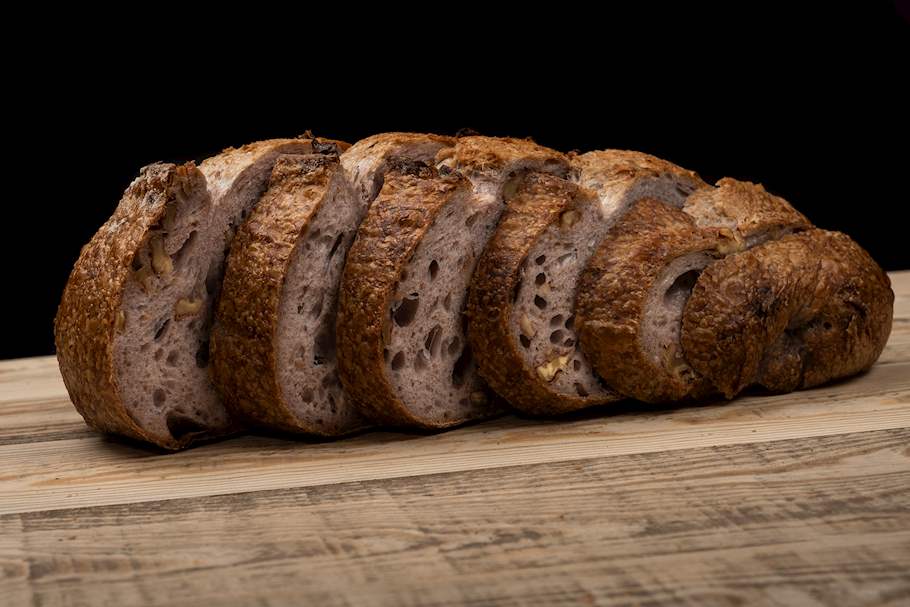Authentic Ciabatta Recipe
 Adria, Italy
Adria, Italy
JUMP TO RECIPE
We strongly advise you to read the cooking tips before jumping to the recipe though
Introduction & history
Light, crusty on the outside, and porous on the inside, ciabatta is an omnipresent Italian bread whose oval, slightly elongated form resembles a slipper. Its preparation takes quite a lot of time and skill, but the result is worth the effort. The first step is to prepare the biga or poolish, a starter dough made from beer yeast, some lukewarm water, and white wheat flour. The original recipe calls for special Uno Natura flour, but recipes for homemade ciabatta suggest using the mixture of Manitoba flour and Italian type 00 flour, which are responsible for a dough with extra elasticity. The starter dough needs to ferment between 12 and 24 hours at a controlled temperature, after which the remaining flour, sugar, salt, and water are added. The dough is folded gently and left to rise repeatedly during the process, as this way it becomes laced with bubbles which are the main characteristic of ciabatta. Ciabatta does not require additional grease or eggs, but water can ... Read more
Cooking tips
-
method
The technique used for the preparation of ciabatta is called the sponge and dough method. This two-step process begins with making a starter dough (also called a sponge, yeast starter or yeast pre-ferment, while the Italians call it biga and poolish) by mixing a part of the flour, a part of the water and a part of the yeast, which are then left to ferment. The fermentation process can last from 12... Read more -
yeast
Usually, ciabatta is based on beer yeast, either dry or fresh. The yeast is dissolved in lukewarm water. If the water is too cold, or the room temperature is too low, it will fail to rise properly. -
flour
The original recipe for ciabatta calls for Uno Natura flour, but a mixture of fine Manitoba flour and Italian type 00 flour can also be used. These flours develop a high amount of gluten during kneading and should be sifted to obtain an airy texture. -
kneading
After the dough has risen and is ready for baking, no kneading is allowed since it would destroy the fragile bubbles on the inside. Rather than kneading, the dough is gently folded 2-3 times and then cut with a knife or a dough cutter into separate ciabattas of the desired size. -
baking
Ciabattas are baked in a very hot oven which should be steamed during the first half of baking. To achieve that, sprinkle the inside of the oven with 5-6 handfuls of water, or place a small bowl of water on the bottom, or simply toss in 5-6 ice-cubes. Then, place the baking pan with the ciabattas into the oven. The steam will allow the dough to continue rising without forming a crust too soon. When ... Read more
Recipe variations
Ciabattas With Olives and Walnuts
PREP 3h 30min
COOK 20min
READY IN 3h 50min
This upgraded version of a classic ciabatta enriched with walnuts and olives can be served as a hearty appetizer with a glass of chilled Italian wine.
Ingredients
Ciabattas With Olives and Walnuts
300 g olives
150 g walnuts
3 thyme sprigs
15 g yeast
1 tsp sugar
200 ml water
600 g flour
pinch of salt
4 tbsp extra virgin olive oil
150 ml water
20 g hard wheat semolina
Preparation
Ciabattas With Olives and Walnuts
To begin, prepare the ingredients for the filling. Pit the olives and drain them. Wash the thyme and remove the leaves. Roughly chop the walnuts with a knife.
Put the yeast in a bowl with 1/2 tsp of sugar. Pour in 200 ml of lukewarm water and combine with a fork. Add 300 g of sifted flour, a pinch of salt and the remaining 1/2 tsp of sugar. Cover and let it rise for 30 minutes.
Now, add the remaining 300 g of sifted flour, 2 tbsp of olive oil and 150 ml of lukewarm water. Knead until the dough becomes elastic. Form the dough into a ball and grease with 1 tbsp of olive oil. Cover with a damp cloth and let it rise for 1 hour.
After 1 hour, knead the dough briefly and divide it into 4 oval-shaped pieces, measuring roughly 30 x 15 cm.
Cover each leaf with the filling mixture, roll, and press gently. Sprinkle with the remaining 1 tbsp of olive oil. Transfer to a baking pan lined with baking paper and let rise for 1,5 hours.
Sprinkle semolina over the surface of each ciabatta and bake for 20 minutes at 220˚C. If you wish, drizzle with more olive oil after baking and serve warm or cold.
Other Variations
Other authentic recipes









Rating And Comments
Rate It
Wanna try?
Add To List